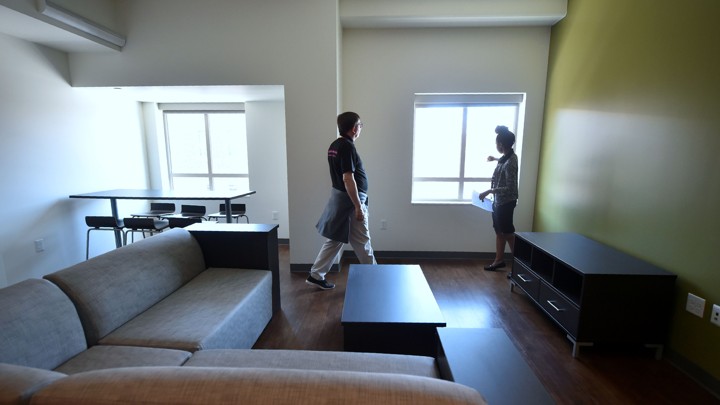Why Dorms Are So Nice Now – The Atlantic

If Amazon doesn't have a Whole Foods grocery near you, there are non-perishable groceries ( food that doesn't spoil) that Amazon can ship to you

Why Dorms Are So Nice Now

At some schools, the building continues. “The vision is to develop the coolest, hippest, most compelling destination in downtown,” the president of Emerson College, in Boston, told Architectural Digest last year when discussing a project that includes a new cafeteria and dorm. Meanwhile, at Arizona State University, a new residence hall for engineering students has 3-D printers, a fitness center, and Wi-Fi that can handle multiple devices per student.
Campus living has entered a new era. For most of the history of American higher education, dormitories were not particularly comfortable, or even plentiful. “Well through the 19th century, even at small liberal-arts colleges that gave a lot of lip service to the idea of a residential college, students usually boarded in neighboring houses,” said John Thelin, an education scholar at the University of Kentucky. “Very few colleges had the money to build complete dormitories for all their students.”
In the mid-’80s, a confluence of factors led colleges to compete more intensely for enrollees, and they began orienting themselves more toward the desires of students. “You have upper-middle-class families visiting a campus, and parents are saying, ‘My goodness, we’re paying this amount of money for tuition for our son or daughter, and they’re living in this nondescript place,’ [one] that may not be well maintained,” Thelin said.
The rationale for building fancier dorms and rolling out plush amenities is that doing so might entice prospective students—especially those who can afford to pay full tuition—in a competitive higher-education market. But it’s not clear that this reliably pays off. Kevin McClure, a professor of higher education at the University of North Carolina at Wilmington, calls this the “If you build it, will they come?” question. “I don’t know that there is that much in the way of empirical evidence that directly says, ‘By building new facilities, you necessarily attract more students,’” he told me. Arriving at such a determination, he said, would require clearly defining what counts as luxurious (granite countertops? nickel finishes?) and data that track the presence of those features in the nation’s dorms. Neither a straightforward definition nor such a specific data set exists.
There is some evidence that prospective students discriminate between schools based on how nice their campuses are. The authors of a 2015 study looking at colleges’ spending found that “many students do appear to value college consumption amenities,” and in particular that wealthier students seemed to be “much more willing to pay for consumption amenities.” However, McClure said, there aren’t conclusive—or granular enough—data pointing to a causal link between building fancy dorms and achieving enrollment goals.
Besides, he articulated a bunch of reasons colleges build new dorms that don’t have to do with wooing amenity-hungry students: Some schools need to accommodate growing student bodies. Some are trying to transition from commuter campuses to residential campuses. Some conclude that having students live on campus will increase retention and improve academic outcomes, so they may require, say, first-year students to do so—which means increasing the number of beds.
Still, some colleges build nicer buildings than they need to, said Brian Mitchell, a former president of Bucknell University and a co-author of How to Run a College. I asked Mitchell what he’d advise if I were in charge of a school that was losing a lot of students to top-tier competitors—should I invest in housing? “I think there are other places you could better spend your money,” he said. Maybe invest instead in differentiating some academic programs from those at other institutions, he suggested.
Of course, college leaders are often beholden to economic forces beyond their control. For instance, McClure noted, private developers pitching high-end off-campus apartments can set a standard of living that schools feel compelled to match. “If a [university] wants to keep a certain percentage of its students on campus, it has to compete with those private off-campus providers,” he said.
Relatedly, McClure pointed out that when schools can’t afford to build a dorm on their own, they often turn to private developers to finance the project, which sometimes means handing over a certain amount of control. With that control, developers might elect to build accommodations that students can be charged higher rates for—which lets the developers recoup their costs more quickly.
It’s not exactly clear that this escalation of amenities actually improves the college experience. John Thelin told me that in every era of higher education, the students’ written accounts that he’s studied dwell on the social world they created—one that existed apart from administrators’ directives and expectations. The setting was always secondary to the meaning created there. “It could be in a really extravagant building, but it could also be in a very humble one,” Thelin said of the spaces in which lasting memories were formed. Somewhere along the path to today’s comfy campuses, it seems this point got lost.

 College Dorm and Apartment Cooking gadgets - if you change the sort settings on the Amazon page, it will show other items by price
College Dorm and Apartment Cooking gadgets - if you change the sort settings on the Amazon page, it will show other items by price

















